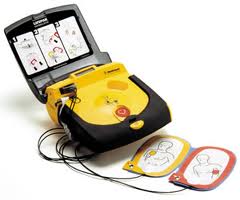Automated external defibrillator (AED)

Automated external defibrillator (AED) is a portable, computerized device to shock a HEART in fibrillation (rapid, useless contractions) into a functional rhythm. AEDs debuted in the 1990s and now are available in many public locations and workplaces. Older models are the size of a small briefcase; newer models are smaller and lighter, with some designed for transport by rescuers on bicycles or on foot. Though manufacturers and emergency medical response experts recommend people obtain training in their use, the devices are simple enough for anyone to use without training. Most models use a computerized voice to provide step-by-step instructions. Once the rescuer applies the pads to the chest of the person having the HEART ATTACK, the AED automatically reads the electrical activity of the heart and determines whether there is sufficient activity for an electrical shock to be therapeutic. An electrical shock cannot help a heart that has no electrical activity. The AED is preset to deliver a precise level and length of shock. AEDs are also available for home use by people at high risk for life-threatening arrhythmias. Many emergency response courses, including the basic life support curriculum, routinely teach AED use.
See also ARRHYTHMIA; CARDIAC ARREST; CARDIOPULMONARY RESUSCITATION (CPR); CARDIOVERSION; ELECTROCARDIOGRAM (ECG); SUDDEN CARDIAC DEATH.